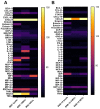Comparative Analysis of Natural and Cytochalasin B-Induced Membrane Vesicles from Tumor Cells and Mesenchymal Stem Cells
- PMID: 36354675
- PMCID: PMC9688684
- DOI: 10.3390/cimb44110363
Comparative Analysis of Natural and Cytochalasin B-Induced Membrane Vesicles from Tumor Cells and Mesenchymal Stem Cells
Abstract
To date, there are numerous protocols for the isolation of extracellular vesicles (EVs). Depending on the isolation method, it is possible to obtain vesicles with different characteristics, enriched with specific groups of proteins, DNA and RNA, which affect similar types of cells in the opposite way. Therefore, it is important to study and compare methods of vesicle isolation. Moreover, the differences between the EVs derived from tumor and mesenchymal stem cells are still poorly understood. This article compares EVs from human glioblastoma cells and mesenchymal stem cells (MSCs) obtained by two different methods, ultracentrifugation and cytochalasin B-mediated induction. The size of the vesicles, the presence of the main EV markers, the presence of nuclear and mitochondrial components, and the molecular composition of the vesicles were determined. It has been shown that EVs obtained by both ultracentrifugation and cytochalasin B treatment have similar features, contain particles of endogenous and membrane origin and can interact with monolayer cultures of tumor cells.
Keywords: cytochalasin B; extracellular vesicles; glioblastoma; mesenchymal stem cells; tumor microenvironment; ultracentrifugation.
Conflict of interest statement
The authors declare no conflict of interest. The funders had no role in the design of the study; in the collection, analyses, or interpretation of data; in the writing of the manuscript; and in the decision to publish the results.
Figures







Similar articles
-
Increased Yield of Extracellular Vesicles after Cytochalasin B Treatment and Vortexing.Curr Issues Mol Biol. 2023 Mar 15;45(3):2431-2443. doi: 10.3390/cimb45030158. Curr Issues Mol Biol. 2023. PMID: 36975528 Free PMC article.
-
Comparative analysis of extracellular vesicles isolated from human mesenchymal stem cells by different isolation methods and visualisation of their uptake.Exp Cell Res. 2022 May 15;414(2):113097. doi: 10.1016/j.yexcr.2022.113097. Epub 2022 Mar 9. Exp Cell Res. 2022. PMID: 35276207
-
Analysis of the Interaction of Human Neuroblastoma Cell-Derived Cytochalasin B Induced Membrane Vesicles with Mesenchymal Stem Cells Using Imaging Flow Cytometry.Bionanoscience. 2022;12(2):293-301. doi: 10.1007/s12668-021-00931-5. Epub 2022 Mar 4. Bionanoscience. 2022. PMID: 35261871 Free PMC article.
-
The Dual Role of Mesenchymal Stromal Cells and Their Extracellular Vesicles in Carcinogenesis.Biology (Basel). 2022 May 25;11(6):813. doi: 10.3390/biology11060813. Biology (Basel). 2022. PMID: 35741334 Free PMC article. Review.
-
Extracellular Vesicles in Physiology, Pathology, and Therapy of the Immune and Central Nervous System, with Focus on Extracellular Vesicles Derived from Mesenchymal Stem Cells as Therapeutic Tools.Front Cell Neurosci. 2016 May 2;10:109. doi: 10.3389/fncel.2016.00109. eCollection 2016. Front Cell Neurosci. 2016. PMID: 27199663 Free PMC article. Review.
Cited by
-
Cell membrane vesicles derived from hBMSCs and hUVECs enhance bone regeneration.Bone Res. 2024 Apr 9;12(1):23. doi: 10.1038/s41413-024-00325-9. Bone Res. 2024. PMID: 38594236 Free PMC article.
References
-
- Simhadri V.R., Reiners K.S., Hansen H.P., Topolar D., Simhadri V.L., Nohroudi K., Kufer T.A., Engert A., Pogge von Strandmann E. Dendritic cells release HLA-B-associated transcript-3 positive exosomes to regulate natural killer function. PLoS ONE. 2008;3:e3377. doi: 10.1371/journal.pone.0003377. - DOI - PMC - PubMed
-
- Koniusz S., Andrzejewska A., Muraca M., Srivastava A.K., Janowski M., Lukomska B. Extracellular Vesicles in Physiology, Pathology, and Therapy of the Immune and Central Nervous System, with Focus on Extracellular Vesicles Derived from Mesenchymal Stem Cells as Therapeutic Tools. Front. Cell. Neurosci. 2016;10:109. doi: 10.3389/fncel.2016.00109. - DOI - PMC - PubMed
Grants and funding
LinkOut - more resources
Full Text Sources

